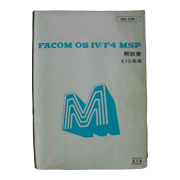OSIV/F4 MSP (Multidimensional System Products) was Fujitsu’s super-large general-purpose operating system (hereinafter “OS”), and was announced in June 1982. This OS was developed to meet the demands of the expansion and advancement of information processing, through further development of the existing super-large general-purpose OS OSIV/F4. The background of the demands for large-scale information systems was the pressures, such as increasing processing capacity, reliability, number of users and new application areas which included OA (office automation).
The following describes the new functions and functional enhancements of OSIV/F4 MSP.
The following new functions were provided with OSIV/F4 MSP:
Adoption of new architecture with a 31-bit addressing method dramatically expanded the virtual memory address space from 16 MB to 2 GB. In addition, the support for the 2-GB virtual memory address space was provided together with the high-level language FORTRAN 77 and online database AIM, first in the world. As a result the OS had a major effect on the fields of huge engineering computation and large-scale online systems.
Subsequently, the 2-GB virtual memory space was also supported in COBOL and assembler language (announced in November 1984).
As functional enhancements of JEF, the OS supported a business graphics function that combined Japanese characters and graphs to make information assessment more accurate. This ensured office productivity increasing and faster decision-making. Additionally, JEF facsimile support allowed outputting to convenient facsimiles in Japanese.
AIM/RDB, a relational database in an intuitive data structure of a table form, enabled the end user to easily develop and operate a database. This realized a new form of information processing that responded to diversifying of business applications, by using different type of database according to application, through coexistence with a network database that had been already available.
Provision of E10 (Edition 10) of OSIV/F4 MSP started in March 1983, and provision of E20 (Edition 20), which supported a 2-GB virtual memory address space, began in January 1984. Subsequently, the functional enhancements indicated in the following table were announced
OSIV/F4 MSP was succeeded by OSIV/MSP (abbreviated as MSP-EX), which was announced in June 1989.
Of the functional enhancements of OSIV/F4 MSP, the hot-standby system building function of AIM V12 announced in November 1984 served as the fundamental technology for the systems that required high processing capacity and high reliability, including 3rd-generation online banking systems.
AIM V12 provided AIM/SRCFM (AIM/Shared Resource Control Facility), which enabled a load-sharing (load distribution) method whereby multiple host computers shared files/databases, in order to achieve high processing capacity. Previously, exclusive control of shared files was performed using reserve/release commands of hardware., and the unit of its exclusive control was a volume of magnetic disk. However, AIM/SRCF achieved exclusive control in database pages based on software through reduction of the overhead in communication between systems by adopting an inter-system communication device called FSI (Fujitsu Subsystem Interface), and a majority decision method. This enabled multiple systems to simultaneously access a database, and allowed the user to achieve high transaction processing capacity by distributing business applications to multiple systems.
In addition, AIM/SRCF provided a hot-standby function that allowed the system to have a business operation taken over by a standby system within approximately one minute, when a production system had encountered failure. In AIM/SRCF, the standby system was waiting in the condition of standby state, which meant that the system had finished a sequence of system opening from the opening of AIM to the opening of an application program. When an error occurred in the active production system, AIM/SRCF recovered the database, which had been being accessed by the active system, and AIM/SRCF had the waiting application program activate, then allowed the standby system to continue operating as the active system.
| Announce-ment date | Major features | Edition | Shipment date |
|---|---|---|---|
| June 1982 |
・Announcement of OSIV/F4 MSP
-Support for 2-GB virtual memory space (E20) -Support for various media (E10) -Relational database AIM/RDB (E10) -Support for a disk cache (E10) |
E10,E20 |
E10: March 1983 E20: January 1984 |
| November 1984 |
・Enhancements of OSIV/F4 MSP
-Strengthened performance of online database AIM Achieved a high processing capacity that enabled processing of 350,000 to 400,000 or more transactions/hour per system. -Establishment of a hot-standby system Provided database-sharing system AIM/SRCF, which used high-speed inter-system connection device FSI, and VTAM-G/DCRF, which automatically switched between communication control processors. In conjunction with a monitoring device, the OS made it possible to build a hot-standby system in which the active system could be switched to the standby system in the event of failure. -Provided an inter-system sharing function of DVCF (duplexed volume control), which made duplex database and files. -Provided new time-sharing system TSS/E, which drastically increased the previous TSS performance and functionality. -Use of a 2-GB virtual memory space using high-level language COBOL and assembler language |
E20 | March 1985 to October 1986 |
| November 1985 |
・Enhancements of OSIV/F4 MSP
-The first general-purpose system to support C language - Provision of COBOL 85, compliant with the new US standard (ANS) of COBOL |
E20 | February 1986 |
| - |
・Functional enhancements of AIM V12 (common to OSIV/F4 MSP, OSIV/X8 FSP and OSIV/ESPIII)
-Support for presentation files (integration of TSS/AIF and screen editor of AIM, in common with the FACOM K series and the FACOM G series) -AP/EF(*1) and AP/DF(*2), which realized prototyping of simplified online and mission critical online -Integrated distribution support for slips: APS(*3) -High-level language COBOL 85, which supported a presentation file function ・Host-workstation linkage function LINKSERV
-DSM(*4),DRMS(*5),CJMS(*6),DTS(*7) |
E20 | June 1987 to June 1988 |
*2 AP/DF:Application Program Environment/Development Facility
*3 APS:Advanced Printing Subsystem
*4 DSM:Distributed System Manager
*5 DRMS:Distributed Resource Management Support
*6 CJMS:Computer Network Job Management System
*7 DTS:Data Transfer Service



